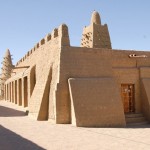Timbuktu Ancient Cultural City Tries To Recover From Attacks

Timbuktu Ancient Cultural City Tries To Recover From Attacks
Timbuktu, the ancient and diverse cultural city situated in one of the less hospitable places on earth is trying to recover after recently being liberated from Muslim extremists by French and African forces.
Timbuktu is a U.N. Heritage site that is filled with history and culture, with ancient mosques, mausoleums and museums that harbor some of the most important manuscripts from this region of the world.
Some of the manuscripts are close to 900 years old and were attained between 1980 and 2000 from all over Mali, and were sent to the Ahmed Baba Institute for Higher Learning and Islamic Research, which held in total close to 30,000 manuscripts.
The ancient city of Timbuktu, famous for its terracotta colored mud buildings and cultural events had a diverse population from its very founding with Tuareg, Berbers, Arabs and black Africans living together in harmony for centuries.
The city also hosted a series of international cultural events like music and film festivals giving it a more diverse cultural side.
It was the indigenous Tuareg that first set their tents next to the Niger Rivers. Those tents turned into buildings and a prosperous city that harbored poets, doctors, scientists clerics and artists grew rapidly.
After being liberated form Muslim extremists this Tuesday, Timbuktu is still counting its losses as a series of irreplaceable scrolls, manuscripts, and tombs were burned or destroyed.